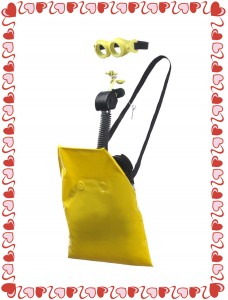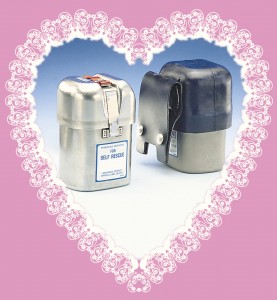Respirator Care = Safe to Wear!
Posted on by
Happy Valentine’s Day! And on this most romantic day of the year, what else could you possibly do than show some love … to your respirator. Last year on this day, we blogged about maintaining your relationship with your Self-Contained Breathing Apparatus (SCBA). To continue to spread the love, this year we want to focus on those mining professionals who work up close and personally with Self-Contained Self-Rescuers (SCSRs). An SCSR is a lifesaving device that miners depend upon in times of emergency to escape from a hazardous environment within the mine. To keep this important device functioning reliably, daily inspections and upkeep become a ‘life or death’ matter. Though you may consider this to be a high-maintenance relationship, it is worth the necessary attention. In the event of an emergency, you need to successfully don and activate your respirator as quickly as possible to escape from danger.
Manufacturer-recommended cleaning, handling, and visual inspection must be properly performed in order to ensure that your SCSR is functioning reliably. For example, a loose chemical bed or lack of starter oxygen can be the product of rough handling or a manufacturing defect, and these types of issues could go unnoticed without regular inspections. But you can easily get to know your respirator on a more intimate level and become aware of these issues. A good cleaning with a brush followed by visual inspection of the respirator case and indicators can identify failing respirators that need to be removed from service.
Respirator Care = Safe to Wear!
- Follow the manufacturer’s instructions. How often is it that you get an instruction guide on how to maintain a relationship? Always carry and clean your SCSR as recommended by the manufacturer in order to avoid damage to your SCSR, such as excessive dents to the case. Store and use your SCSR within the manufacturer-specified temperature limits. Both excessive denting and exposure to temperature extremes can cause your SCSR to malfunction.
- Keep your SCSR free of dirt. Brushing dirt from your SCSR case daily will allow for proper day-to-day inspection. NIOSH research has found that dirt can hide problems or even cause damage to the device. During a recent NIOSH study, an in-service SCSR respirator was brushed to clean the soiled device. In the process, the researchers discovered a cracked moisture indicator. Had this SCSR been cared for on a daily basis, the indicator damage would have been discovered and the respirator would have been removed from service. This hidden flaw was a danger to the miner depending on the device in case of an emergency. When an indicator is damaged, an SCSR should always be removed from service.
- Check the sealing features of your SCSR case. A damaged seal can allow dirt or moisture into the case, which may cause your respirator to malfunction in an emergency situation.
If any part of your respirator is defective, get a replacement.
You only have one chance to escape from most mine emergencies. Clean and thoroughly inspect your SCSR every day. Your life may depend on it; so give your respirator this care so that you can enjoy many Valentine’s Days with those that care for you!
Courtney Neiderhiser, MS and Jaclyn Krah, MA
Ms. Neiderhiser is a physical scientist in the NIOSH National Personal Protective Technology Laboratory.
Ms. Krah is a Health Communication Specialist in the NIOSH National Personal Protective Technology Laboratory.
7 comments on “Respirator Care = Safe to Wear!”
Comments listed below are posted by individuals not associated with CDC, unless otherwise stated. These comments do not represent the official views of CDC, and CDC does not guarantee that any information posted by individuals on this site is correct, and disclaims any liability for any loss or damage resulting from reliance on any such information. Read more about our comment policy ».



Interesting, I am curious as to who should check the SCSR’s ? Obviously the user each day before work but should there be checks made by a professional? and if so would each device receive a certificate of inspection?
Health and Safety Documents
Mines typically have a safety representative that performs manufacturer recommended quarterly maintenance on SCSRs. On a daily basis it is the user’s responsibility to make sure their respirator passes all recommended manufacturer visual checks. Each respirator manufacturer provides training, and MSHA provides training to miners as well (see http://www.msha.gov/Streaming/SCSRClips.asp ).
Thanks for amazing posts ,, keep sharing that type of articles.
Well-written and fun to read! Given that it is authored by government employees, it could be copied and modified (with credit to NIOSH and the original authors) to apply to many types of equipment that can pose or exacerbate hazards if not properly maintained. Kudos!
Thanks for amazing posts ,, keep sharing that type of articles.
I remember last years blog.. This one was better love reading the blogs you make.
Mines typically have a safety representative that performs manufacturer recommended quarterly maintenance on SCSRs.